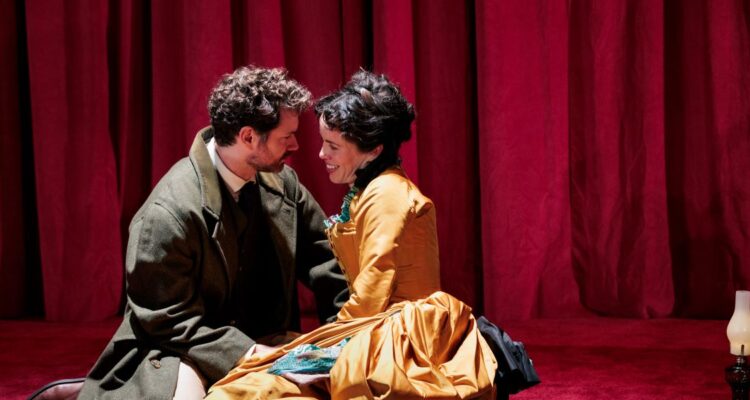The Forsyte Saga has a venerable creative history – whether in the form of the long sequence of novels that were a must-read for my grandparents’ generation, or the much-celebrated TV series in 1967 and 2002. This two-part adaptation deserves to stand alongside them as a transcendant example of what theatrical representation can uniquely do that other media cannot.
Let’s start with the excellent, judicious work of the two adapters, Shaun McKenna and Lin Coghlan. Starting from their radio version from a few years ago, they have successfully streamlined this huge work to focus on the core conflicts within one divided family, using Fleur Forsyte, one of the leads in the second part, as the narrator of the first. Thanks to the suave, silky elegance of Flora Spencer-Longhurst’s performance gaps are filled and transitions made without in any way impeding the naturalistic flow of the action. The only omission that bothers me to some extent is that of Winifred Dartie, Soames Forsyte’s sister, who is an important player in the original.
The action spans some forty years, from the 1880s to the 1920s, and the creative team, led by director Josh Roche, have taken some excellent decisions to achieve period style without period literalism. The thrust stage is covered with a rich red carpet that implies plush interiors without cluttering the stage with furniture that would impede movement. Similarly a curtain across the back wall is used to suggest generous vistas which can be safely left to the imaginative evocation of the actors. Costumes change in line with the times, but also gently indicate the essence of character. Above all the meticulously detailed lighting designs and soundscapes created by Alex Musgrave and Max Pappenheim summon up the changing, busy world of Victorian London. I was especially impressed at the way in which we get to feel we know the modernist house Robin Hill and its beauteous setting in the Surrey Hills, without ever seeing it. Our imaginations are stimulated to fill in the rest and the role it plays in the lives of so many of the characters across the generations.
If we start with the achievement of the creative team it is in no way to downplay the work of the cast. This is imaculate ensemble work with most of the cast taking on multiple roles which they distinguish one from another with rare technical skill. There is a vast amount of text to deliver, here done with rare discernment; and in the absence of a detailed set a great deal of physical acting too, both searingly moving and truly funny. The punting episode in Part Two is a particular highlight, but there are so many others too.
The actors in the leads have a tricky task to accomplish. Soames, Irene and Fleur are all in various ways unattractive characters, with Soames and his daughter, in particular, embodying the dangers of carrying over possessive attitudes to property into relationships. But Irene, too, though a victim, is also a manipulative figure. Each of the actors succeeds in engaging our sympathies even as we deplore many of their stances and actions. Joseph Millson captures the clenched intensity of Soames, demonstrating the searing, self-destructive costs of unrequited love. Fiona Hampton suggests the serene surface of Irene and the capacity for passion within; and Flora Spencer-Longhurst wins you over with her energy and brio just as she dismays with her spoilt wilfulness.
There is sadly no space in a short review to do justice to all the other players, so I would just note a few immensely skilful performances. Andy Rush has to play the romantic male leads in both halves – tortured architect Philip Bossiney and guileless ingenu, Jon Forsyte. He distinguishes them gracefully and with conviction. Michael Lumsden emobodies the wisdom and ability to think beyond convention that is at the centre of Old Joylon’s character, and Emma Amos embraces both conventional and unconventional women with equal success, but particularly as the older June Forsyte. Florence Roberts finds real range and impeccable French and American accents accross three roles and Jamie Wilkes impressed me hugely for the depth and detail of characterisation he evoked, whether in the form of the rebel Jo Forsyte, or as Michael Mont, a role that is too often played as if a character on the run from a P.G. Wodehouse novel. Nigel Hastings has not much to work with as Soames’ father, James, but came into his own as the world-weary older Jo Forsyte in Part Two.
The great feature of the original novels is that they are not shy of addressing large themes of social change but always channelled through gripping human interaction between wholly credible characters. This adaptation is faithful to that balance. The first half is slightly more compelling than the second, which reflects the fact that John Galsworthy himself is less comfortable and assured as a commentator on the 192os than on the Victcorian world of which he was a product. But this is no criticism of this representation which is one of the two or three the most compelling and convincing evenings in the theatre I have experienced this year. It is a must-see production.
John Galsworthy, Adapted by Shaun McKenna and Lin Coghlan
Directed by Josh Roche
Cast: Emma Amos, Fiona Hampton, Nigel Hastings, Michael Lumsden, Joseph Millson,
Florence Roberts, Andy Rush, Flora Spencer-Longhurst and Jamie Wilkes
Until 7 December 2024
2hrs 20 mins each part with interval
Photo Credit: Mitzi de Margary

